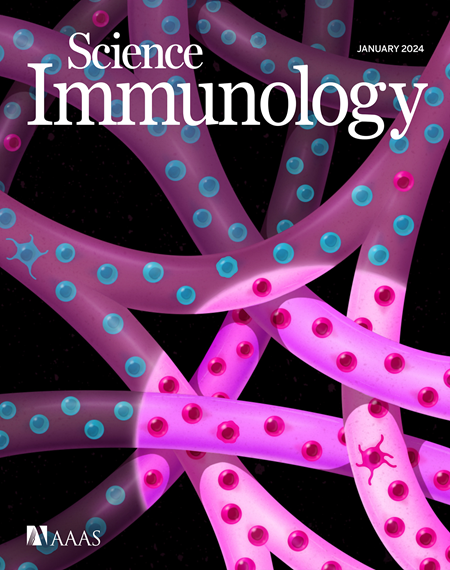设计一种有效的白介素-21模拟物用于癌症免疫治疗
IF 16.3
1区 医学
Q1 IMMUNOLOGY
引用次数: 0
摘要
癌症免疫治疗的长期目标是在抑制调节性T细胞的同时,激活对肿瘤抗原具有亲和力的细胞毒性抗肿瘤T细胞。计算蛋白质设计使精确剪裁蛋白质以满足特定需求成为可能。在这里,我们报道了一种从头设计的IL-21模拟物21h10,它在人和小鼠中具有高稳定性和信号效力。在小鼠和离体人器官型肿瘤模型中,21h10表现出较强的抗肿瘤活性,其信号传导时间更长,抗肿瘤活性强于天然IL-21。21h10诱导的胰腺炎可以通过TNF阻断而不影响抗肿瘤效果。虽然形成了针对21h10的抗药抗体,但它们没有被中和。与天然IL-21相比,21h10诱导具有多种亲和力的高细胞毒性T细胞,显著扩增肿瘤内低亲和力的细胞毒性T细胞,驱动IFN-γ和颗粒酶B的高表达,同时增加IFN-γ + T辅助1细胞的频率,减少调节性T细胞。充分的人-鼠交叉反应性、高稳定性和效力以及低亲和力的抗肿瘤反应支持了21h10的翻译潜力。本文章由计算机程序翻译,如有差异,请以英文原文为准。

Design of a potent interleukin-21 mimic for cancer immunotherapy
Long-standing goals of cancer immunotherapy are to activate cytotoxic antitumor T cells across a range of affinities for tumor antigens while suppressing regulatory T cells. Computational protein design has enabled the precise tailoring of proteins to meet specific needs. Here, we report a de novo designed IL-21 mimic, 21h10, with high stability and signaling potency in humans and mice. In murine and ex vivo human organotypic tumor models, 21h10 showed robust antitumor activity, with more prolonged signaling and stronger antitumor activity than native IL-21. 21h10 induced pancreatitis that could be mitigated by TNF blockade without compromising antitumor efficacy. Although antidrug antibodies to 21h10 formed, they were not neutralizing. 21h10 induced highly cytotoxic T cells with a range of affinities, robustly expanding intratumoral low-affinity cytotoxic T cells and driving high expression of IFN-γ and granzyme B compared with native IL-21, while increasing the frequency of IFN-γ+ T helper 1 cells and reducing regulatory T cells. The full human-mouse cross-reactivity, high stability and potency, and low-affinity antitumor responses support the translational potential of 21h10.
求助全文
通过发布文献求助,成功后即可免费获取论文全文。
去求助
来源期刊

Science Immunology
Immunology and Microbiology-Immunology
CiteScore
32.90
自引率
2.00%
发文量
183
期刊介绍:
Science Immunology is a peer-reviewed journal that publishes original research articles in the field of immunology. The journal encourages the submission of research findings from all areas of immunology, including studies on innate and adaptive immunity, immune cell development and differentiation, immunogenomics, systems immunology, structural immunology, antigen presentation, immunometabolism, and mucosal immunology. Additionally, the journal covers research on immune contributions to health and disease, such as host defense, inflammation, cancer immunology, autoimmunity, allergy, transplantation, and immunodeficiency. Science Immunology maintains the same high-quality standard as other journals in the Science family and aims to facilitate understanding of the immune system by showcasing innovative advances in immunology research from all organisms and model systems, including humans.
 求助内容:
求助内容: 应助结果提醒方式:
应助结果提醒方式:


